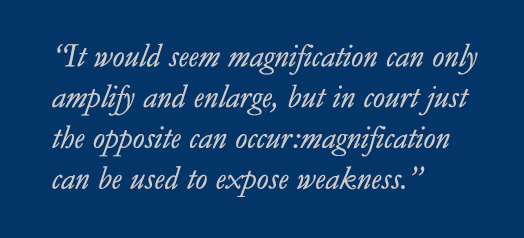Lawyers look forward to cross-examination since at least there’s some sense of being on the attack. For the first time, you’re permitted to be overtly adversarial. Attacking the witness’s credibility, confronting the witness’s ability to see, hear, perceive, or know, condemning the witness for failing to consider those facts most supportive of your side of the case––such methods are routinely utilized. But there are other techniques as well.
Use a magnifying glass to reveal weakness. It would seem magnification can only amplify and enlarge, but in court just the opposite can occur: magnification can be used to expose weakness. The idea is that by focusing on one area, the true strength of the opinion can be revealed. Opposing expert witness testifies to opinion XYZ. Take one thread of this opinion––preferably its weakest strand––and dwell on it, enlarge it, almost as if you’re examining it with a magnifying glass. If the thread is shown to be frayed and unraveling, you’ve successfully cast doubt on the strength of the entire opinion.
Adjust the angle of the plane so the water flows only in your direction. Ask: in what direction is the water flowing? If the natural tendency of the water is to drift away from your side of the case, you need to adjust the angle of the plane. Build a conduit, construct a wall, tilt the angle in your direction––you’re looking for ways where the natural direction of the case seems to flow effortlessly to your side. Some refer to this as the underlying “theme” of the case. You choose the battleground that gives you the best chance of winning. But that’s not enough. It has to appear that the only direction the water can flow is to your side.
Paint a caricature. If the witness takes an inflexible position, moving the line incrementally upward will expose its lack of validity. Sooner or later, every credible witness will admit to grey areas. If the witness refuses to, that’s an opportunity to show that nothing––no matter what––can ever change the witness’s opinion. Simply put, a witness who refuses to recognize the outer limits of reasonableness is not a reasonable witness. The witness can then be depicted as caricature, worthy of scorn and derision, not belief.
Blow up the balloon, then pop it. You slowly build the witness up, then once inflated, deflate the balloon with a series of pointed questions. The key here is to make sure your ending questions are strong enough to deflate successfully. This technique was used by Earl Rogers in his cross-examination of a key witness during a bribery trial. After questioning designed to build up the witness as a reformer who sought to root out graft and corruption, Rogers adroitly shifted gears, confronting the witness with records indicating payments made by him to the prosecutor and prosecutor’s detective.[1]
Expose the joint. Many favor an indirect approach and cross-examine only those areas where they know the witness is vulnerable. “He was a master of the art of converting his weakness into strength; and the opponent’s strength into a weakness. His tactics, too, had the essential characteristic of the indirect approach––that of getting the opponent off balance, so that a joint becomes exposed and can be dislocated.”[2] By focusing on the most vulnerable areas, your chances of finding a gap––an exposed joint––are increased, thus leading to additional areas of questioning. Remember, you do not need to lift the entire weight of what’s before you––you just have to cause it to fall.
[1] Adela Rogers St. Johns, Final Verdict, pgs. 356-358 (Doubleday 1962).
[2] B.H. Liddell Hart, Strategy, pg. 52 (2nd Ed.)(The New American Library 1974)




